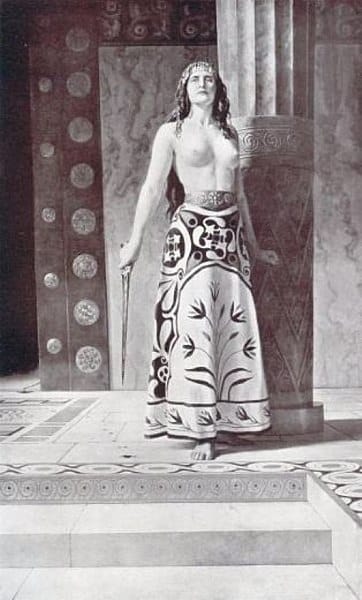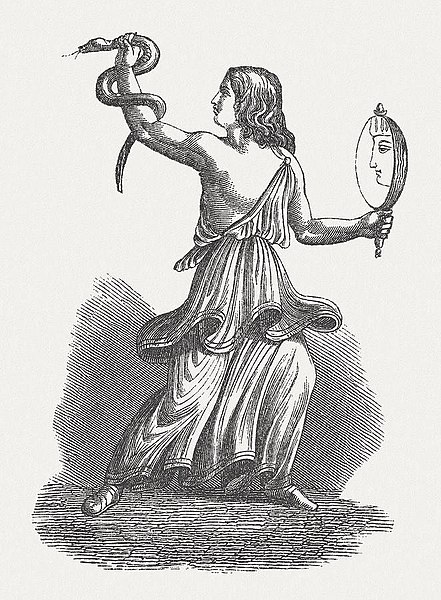In the vast tapestry of Greek mythology, few figures are as compelling and controversial as Clytemnestra. The queen of Mycenae, her story intertwines with some of the most iconic characters and events of the ancient world, painting a portrait of a woman both revered and reviled.
Clytemnestra Key Facts
| Parents | Leda and Tyndareus |
| Partners | Agamemnon |
| Siblings | Helen, Castor and Pollux |
| Offspring | Iphigenia, Chrysothemis, Electra, Orestes |
| Other names | – |
| Roman name | – |
| Best Known Myth | Murder of Agamemnon and affair with Aegisthus |
Name and Etymology
The name Clytemnestra is believed to have its roots in ancient Greek, though its exact etymology remains a subject of debate. Some scholars suggest it means “famed for her suitors,” hinting at the many who sought her hand in marriage. In Roman tales, she doesn’t have a direct counterpart, making her uniquely Greek. Throughout various texts, she’s often referred to by epithets that highlight her role as a queen, a mother, and sometimes, a betrayer.

Clytemnestra’s Family and Relationships
Clytemnestra’s lineage is a blend of divinity and royalty, making her one of the most intriguing figures in Greek mythology. She was the daughter of Leda, a mortal queen, and Tyndareus, the king of Sparta. Leda’s encounter with Zeus, who approached her in the guise of a swan, resulted in the birth of two eggs. From one egg emerged Clytemnestra and her twin sister, Helen, destined to be the cause of the Trojan War due to her unparalleled beauty. The other egg produced the Dioscuri twins, Castor and Pollux, who would later be immortalized among the stars.
Bound by marriage to Agamemnon, the powerful king of Mycenae, Clytemnestra became the queen of a prosperous realm. Their union produced four children: Iphigenia, whose sad fate would become a pivotal point in Clytemnestra’s life; Electra, who would later play a significant role in the family’s tragic narrative; Chrysothemis, often overshadowed by her more famous siblings but still a figure of note in some myths; and Orestes, whose destiny would be irrevocably tied to the actions of his parents.
Myths about Clytemnestra
Clytemnestra’s narrative is a tapestry of love, betrayal, and revenge, deeply intertwined with the fates of those around her. Each myth paints a vivid picture of her character, revealing the complexities of her motivations and actions.
The Sacrifice of Iphigenia
The winds were still, and the Greek fleet, eager to sail to Troy, found themselves stranded. It was prophesied that the winds would only favor them if Agamemnon, the leader of the Greek forces, sacrificed his beloved daughter, Iphigenia, to the goddess Artemis. Torn between duty and love, Agamemnon devised a ruse. He lured Clytemnestra and Iphigenia to Aulis with the promise of a marriage between Iphigenia and the great warrior Achilles.
Upon their arrival, Clytemnestra’s joy turned to horror as she discovered the true intent. The sacrifice went ahead, deeply scarring Clytemnestra’s soul. This act of betrayal, where a father sacrificed his daughter for the sake of war, became the bedrock of Clytemnestra’s thirst for vengeance.
The Murder of Agamemnon
While Agamemnon was away at Troy, Clytemnestra’s loneliness and anger festered. It was during this time that she became acquainted with Aegisthus. Aegisthus had his own vendetta against Agamemnon. The king’s father, Atreus, had killed Aegisthus’ brothers and served them to their father, Thyestes, in a gruesome act of revenge. Aegisthus sought to avenge this atrocity, and in Clytemnestra, he found both a kindred spirit and an ally.
Their bond, forged in shared resentment, soon turned romantic. Together, they plotted Agamemnon’s demise. Upon the king’s return from Troy, Clytemnestra welcomed him with feigned warmth, only to ensnare him in a net or robe and, with Aegisthus’ help, end his life. This act was not just revenge for Iphigenia but also a culmination of old grudges and new alliances.
The Revenge of Orestes
The cycle of vengeance did not end with Agamemnon’s death. Orestes, the son of Clytemnestra and Agamemnon, was tormented by the Erinyes (Furies) and the ghost of his father, urging him to avenge the fallen king. Guided by Apollo and accompanied by his sister Electra, Orestes confronted his mother and Aegisthus.
In a heart-wrenching encounter, Orestes was torn between his duty to avenge his father and the taboo of matricide. Ultimately, the scales tipped in favor of vengeance, and Orestes killed both Clytemnestra and Aegisthus. This act, while avenging Agamemnon, further deepened the curse on the house of Atreus, showcasing the tragic, never-ending cycle of revenge that plagued this royal lineage.
Depiction And Characteristics
Clytemnestra’s portrayal in ancient texts and art is multifaceted. Often, she’s depicted as a strong, regal figure, befitting her status as a queen. Yet, there’s also a darker side, where she’s shown wielding a double-ax, a symbol of her treachery. Her association with the net, used to trap Agamemnon, further cements her image as a cunning strategist.
Her personality, as gleaned from myths, is equally complex. While her actions against Agamemnon can be seen as those of a vengeful wife, they also highlight her strength and determination. In a world dominated by gods and heroes, Clytemnestra carved her own destiny.
Representations Of Clytemnestra In Art
From ancient pottery to grandiose sculptures, Clytemnestra’s presence in art is undeniable. One of the most iconic depictions is on the Mycenae “Lion Hunt Dagger,” where she might be seen mourning Agamemnon. In classical Athenian plays, she’s often portrayed as both a grieving mother and a vengeful wife, reflecting society’s ambivalence towards her.

Mentions in Ancient Texts
Clytemnestra’s story has been woven into the fabric of many ancient texts, each offering a unique perspective on her life and deeds.
Homer’s “Odyssey” (circa 8th century BC)
Homer, the legendary blind poet often considered the cornerstone of ancient Greek literature, immortalized Clytemnestra in his epic, the “Odyssey.” In this work, her treachery serves as a cautionary tale for Odysseus, warning of the dangers that might await him at home. Her fate is briefly mentioned, underscoring the consequences of her actions. A notable excerpt reads: “Do not go gentle to your wife, nor let her know in advance you are coming, but in silence come back, and only to those you trust.”
Aeschylus’ “Oresteia” (circa 458 BC)
Aeschylus, one of the three great tragedians of classical Athens, delved deep into the house of Atreus in his trilogy, the “Oresteia.” Clytemnestra’s multifaceted character is explored in depth, from her grief over Iphigenia to her wrath against Agamemnon. The plays paint a vivid picture of her internal struggles and the tragic consequences of her actions.
Euripides’ “Electra” (circa 410 BC)
Euripides, another of the famed Athenian playwrights, offers a different take on Clytemnestra in his play “Electra.” Here, the focus shifts to her daughter Electra and her thirst for revenge against her mother for Agamemnon’s murder. Euripides portrays Clytemnestra as a woman tormented by her past deeds, seeking justification for her actions.
Sophocles’ “Electra” (circa 409 BC)
Sophocles, the third of the great Athenian tragedians, also tackled the story of Clytemnestra and Electra. In his rendition, Clytemnestra’s character is more assertive, defending her actions with conviction. The play delves into the psychological aftermath of Agamemnon’s murder, with Clytemnestra and Electra’s relationship at its core.
Frequently Asked Questions
She was the daughter of Leda and Tyndareus.
Her anger over the sacrifice of their daughter Iphigenia and her affair with Aegisthus played pivotal roles.
She was killed by her son, Orestes, as revenge for Agamemnon’s death.
Indirectly. While she didn’t fight, her husband’s role and her sister Helen’s elopement with Paris were central to the war.
She had four children: Iphigenia, Chrysothemis, Electra, and Orestes.
While often seen as treacherous, some texts and plays do highlight her grief and reasons for revenge.
Featured Image Credit: Pierre-Narcisse Guérin, Public domain, via Wikimedia Commons
